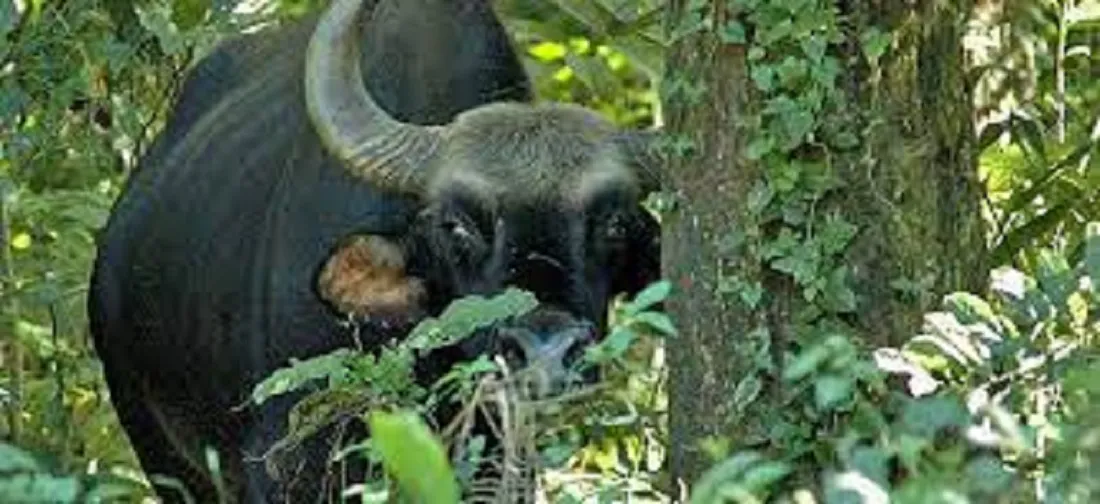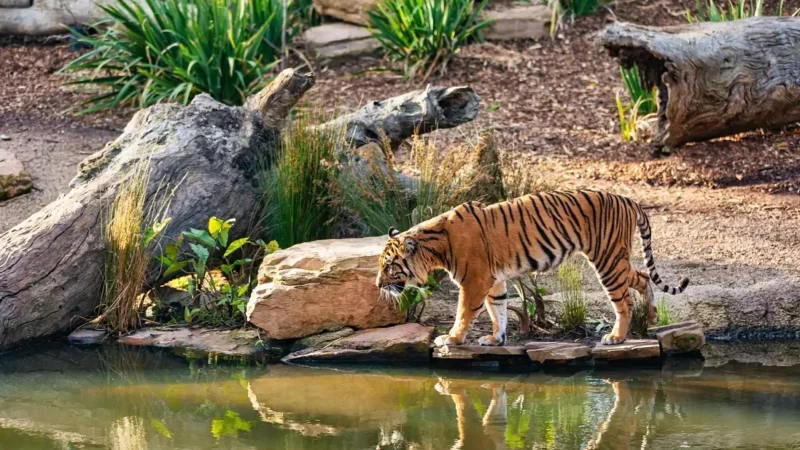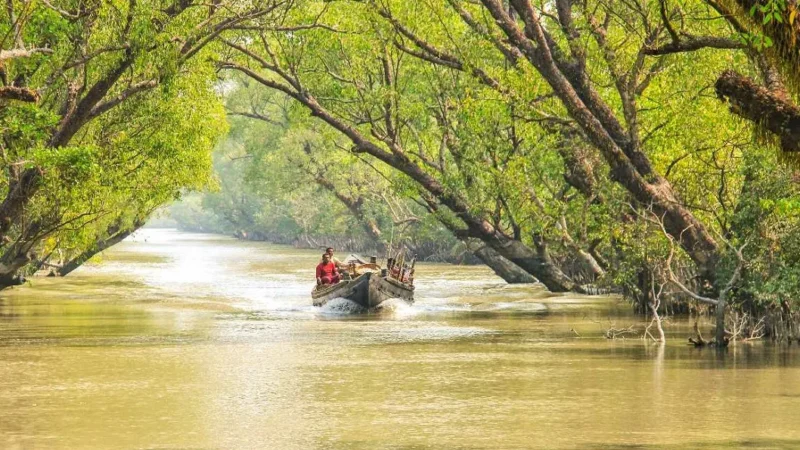Top 15 Wildlife Sanctuary in West Bengal

West Bengal Wildlife Sanctuaries -
Nature has always held a captivating allure, an intricate tapestry woven with diverse and marvelous creatures. In the eastern realms of India, specifically in West Bengal, lies a series of sanctuaries safeguarding these remarkable wild inhabitants. These sanctuaries are not just patches of greenery; they are living, breathing ecosystems teeming with life, each with its unique story to tell.
West Bengal boasts a wide array of landscapes supporting incredible wildlife diversity, from the dense, mist-shrouded forests of the Himalayan foothills to the sprawling mangrove forests along the coast. As we embark on this journey of exploration, we will delve into the heart of these protected havens, uncovering the secrets they hold and shedding light on the tireless efforts put forth to preserve them.
Here are the top 15 wildlife sanctuaries in West Bengal:
1- Sundarbans National Park
The Sundarbans National Park is a UNESCO World Heritage Site located in the delta of the Ganges, Brahmaputra, and Meghna rivers in the Bay of Bengal. It is the world’s largest mangrove forest, covering over 10,000 square kilometers (3,900 sq mi). The park is home to various wildlife, including the Royal Bengal tiger, the saltwater crocodile, and the Ganges River dolphin.
The Sundarbans is a unique and fragile ecosystem threatened by several factors, including climate change, deforestation, and pollution. The park is also vulnerable to cyclones and floods.
Despite the challenges, the Sundarbans National Park is an important protected area for conserving biodiversity and supporting local communities.
Here are some of the things you can do in the Sundarbans National Park:
- Take a boat ride through the mangrove forest.
- Go on a wildlife safari to see the tigers, crocodiles, and other animals.
- Visit a local village to learn about the people who live in the Sundarbans.
- Go bird watching in the park, which is home to over 300 species of birds.
- Relax on a beach or in a riverside resort.
The best time to visit the Sundarbans National Park is during the dry season, from November to April. Due to flooding, the park is closed during the monsoon season, from June to October.
2- Buxa Tiger Reserve
Buxa Tiger Reserve is a tiger reserve and national park in northern West Bengal, India. It covers an area of 760 square kilometers (290 sq mi) and is located in the Dooars region, along the border with Bhutan. The reserve is home to various wildlife, including the Bengal tiger, Asian elephant, gaur, leopard, and clouded leopard.
The reserve was established in 1983 and is one of the 50 tiger reserves in India. It is also a Ramsar Wetland of International Importance.
The reserve is a popular tourist destination for wildlife enthusiasts. There are several activities that visitors can enjoy in the reserve, including jungle safaris, bird watching, and hiking.
The best time to visit the Buxa Tiger Reserve is during the dry season, from November to April. Due to flooding, the reserve is closed during the monsoon season, from June to October.
3- Jaldapara National Park
Jaldapara National Park is a renowned wildlife sanctuary and national park in the Alipurduar district of West Bengal, India. Spread over an area of approximately 216 square kilometers; the park is celebrated for its diverse flora and fauna, including the iconic Indian one-horned rhinoceros.
Flora and Fauna: The park’s vegetation varies from riverine forests, grasslands, and savannahs to deciduous forests. It’s home to various wildlife, making it a popular destination for nature enthusiasts and photographers. Apart from the Indian one-horned rhinoceros, the park houses various animals, including Asian elephants, Bengal tigers, leopards, wild boars, Indian bison, deer species, and various primates.
Safaris and Activities: One of the best ways to experience Jaldapara National Park is through its jungle safaris. Jeep safaris and elephant rides allow visitors to witness the park’s wildlife up close. The excitement of spotting rhinos, elephants, and other creatures against the picturesque landscape’s backdrop adds to the visit’s charm.
Landscape and Geography: The park is located in the foothills of the Eastern Himalayas, offering a stunning landscape of rivers, grasslands, forests, and mountains. The Torsa River flows through the park, enhancing the area’s natural beauty.
Accessibility: The park is easily accessible from towns like Madarihat and Jalpaiguri. It’s advisable to plan your visit during the park’s open season, generally from October to May. During the monsoon months, the park remains closed due to heavy rainfall.
4- Gorumara National Park
Gorumara National Park is in the Dooars region of the Himalayan foothills of West Bengal, India. It is a medium-sized park with grasslands and forests. Gorumara National Park was established in 1992. It is primarily known for its population of Indian one-horned rhinoceros.
The park is home to other wildlife, including elephants, leopards, deer, and monkeys. It is also an important birding destination, with over 300 species of birds recorded in the park.
The best time to visit Gorumara National Park is during the dry season, from November to April. Due to flooding, the park is closed during the monsoon season, from June to October.
Here are some of the things you can do in Gorumara National Park:
- Take a jeep safari to see the rhinos and other animals
- Go for a walk or hike in the forest.
- Visit the Medhla watchtower for panoramic views of the park.
- Go bird watching in the park.
- Visit the Interpretation Centre to learn about the park’s history and wildlife.
5- Neora Valley National Park
Gorumara National Park is in the Dooars region of the Himalayan foothills of West Bengal, India. It is a medium-sized park with grasslands and forests. Gorumara National Park was established in 1992. It is primarily known for its population of Indian one-horned rhinoceros.
The park is home to other wildlife, including elephants, leopards, deer, and monkeys. It is also an important birding destination, with over 300 species of birds recorded in the park.
The best time to visit Gorumara National Park is during the dry season, from November to April. Due to flooding, the park is closed during the monsoon season, from June to October.
Here are some of the things you can do in Gorumara National Park:
- Take a jeep safari to see the rhinos and other animals.
- Go for a walk or hike in the forest.
- Visit the Medhla watchtower for panoramic views of the park.
- Go bird watching in the park.
- Visit the Interpretation Centre to learn about the park’s history and wildlife.
6- Singalila National Park
Nestled along the India-Nepal border in the Darjeeling district of West Bengal, Singalila National Park is a breathtaking Himalayan gem that promises adventure, stunning vistas, and an opportunity to witness the marvels of the Eastern Himalayas. From its towering peaks to its vibrant flora and diverse fauna, this park offers a truly captivating experience for nature enthusiasts and trekkers.
Panorama of Peaks: The park’s most celebrated feature is its panoramic views of the world’s highest peaks. As you trek through the rolling hills and dense rhododendron forests, you’ll be treated to unobstructed vistas of iconic summits like Mount Everest, Kanchenjunga, Makalu, and Lhotse. The spectacle of these snow-capped giants against the clear blue sky is a sight that will forever be etched in your memory.
Flora and Fauna: Singalila National Park has a remarkable plant and animal life diversity. Its lush forests are adorned with rhododendron blooms during spring, painting the landscape in vibrant hues. The park’s fauna includes the elusive red panda, leopard, Himalayan black bear, and various species of deer. Birdwatchers are also in for a treat, with sightings of colorful pheasants and other avian species.
The Trekking Trails: The park’s trekking trails are a haven for adventure seekers. The renowned Singalila Ridge Trek takes you through enchanting forests, alpine meadows, and rhododendron-filled landscapes. The journey culminates at Sandakphu, the highest point in West Bengal, where breathtaking sunrise and sunset views over the Himalayan range are a sight.
A Birdwatcher’s Paradise: Singalila’s avian diversity is a haven for bird enthusiasts. The park boasts an array of species, from the satyr tragopan with its vibrant plumage to the crimson-hued blood pheasant. The musical calls of these birds add an ethereal quality to the trekking experience.
7- Mahavir Wildlife Sanctuary
The Bhagwan Mahavir Wildlife Sanctuary is a protected area in the Western Ghats of Goa, India. It is the largest wildlife sanctuary in Goa and is home to various wildlife, including leopards, elephants, deer, and birds.
The sanctuary was established in 1969 and covers an area of 240 square kilometers (93 sq mi). It is located in the Dharbandora taluk of Goa and is bordered by the Mollem National Park to the south.
The sanctuary is home to a variety of wildlife, including:
- Leopards
- Elephants
- Gaur (Indian bison)
- Sambar deer’
- Spotted deer
- Malabar giant squirrel
- Pythons
- Over 200 species of birds
8- Ballavpur Wildlife Sanctuary
Ballavpur Wildlife Sanctuary, also known as Deer Park, is a small wildlife sanctuary near Santiniketan in Bolpur subdivision of Birbhum District in the Indian state of West Bengal. Established in 1977, it is spread over 200 hectares (490 acres).
The sanctuary is home to various deer, including spotted deer, sambar deer, and blackbuck. It also has a small population of jackals, foxes, and wild boars. The sanctuary is also home to various birds, including the peacock, parakeet, and kingfisher.
The best time to visit the Ballavpur Wildlife Sanctuary is during the dry season, from November to April. Due to flooding, the sanctuary is closed during the monsoon season, from June to October.
Here are some of the things you can do in the Ballavpur Wildlife Sanctuary:
- Take a walk or hike through the forest.
- Visit the deer enclosure.
- Go bird watching.
- Visit the Visitor Centre to learn about the sanctuary’s history and wildlife.
9- Bibhutibhushan Wildlife Sanctuary
Nestled in the serene landscapes of West Bengal, the Bibhutibhushan Wildlife Sanctuary is a hidden gem that offers a peaceful escape into nature’s embrace. Named after the renowned Bengali author Bibhutibhushan Bandyopadhyay, this sanctuary is a testament to the rich biodiversity that the region harbors.
Location and Landscape: Situated in the district of Jalpaiguri, this sanctuary spans an area of approximately 400 hectares. Its lush forests, rolling hills, and meandering streams characterize it, creating a landscape that exudes tranquility and beauty.
Flora and Fauna: The sanctuary is home to various plant species, from towering trees to delicate shrubs. While less extensive than some larger sanctuaries, Bibhutibhushan Wildlife Sanctuary is an essential habitat for local flora. As for fauna, the sanctuary hosts a range of animals, including deer species, wild boars, and various types of birds.
Birdwatcher’s Paradise: For bird enthusiasts, this sanctuary is a delight. The lush greenery and the presence of water bodies attract a variety of avian species. Birds like the Indian pied hornbill, barbets, kingfishers, and sunbirds are just a few examples of the vibrant birdlife that can be spotted here.
Trails and Tranquility: The sanctuary offers tranquil walking trails that wind through its natural beauty. These trails allow visitors to immerse themselves in the serenity of the surroundings and witness the local flora and fauna up close.
10- Sajnakhali Wildlife Sanctuary
Sajnakhali Wildlife Sanctuary is 362 square kilometers (139 sq mi) in the northern part of the Sundarbans delta in South 24 Parganas district, West Bengal, India. It is located at the confluence of the Matla and Gumdi rivers. The area is mainly mangrove scrub, forest and swamp. It was set up as a sanctuary in 1976.
The sanctuary is home to a rich population of different species of wildlife, such as water fowl, heron, pelican, spotted deer, rhesus macaques, wild boar, tigers, water monitor lizards, fishing cats, otters, Olive ridley turtle, crocodiles, Batagur terrapins, and migratory birds. The ideal place for nature lovers to observe wild animals from a height is the Sajnekhali Watchtower.
11- Ramnabagan Wildlife Sanctuary
Ramnabagan Wildlife Sanctuary is a wildlife sanctuary in the Bardhaman district of West Bengal, India. It is spread over an area of 14.31 hectares (35.36 acres). The sanctuary was declared a reserved forest in 1960 and a wildlife sanctuary in 1981.
The sanctuary is home to a variety of wildlife, including spotted deer, common langur, sambar deer, rhesus macaque, python, cobra, and over 100 species of birds
12- Mahananda Wildlife Sanctuary
The Mahananda Wildlife Sanctuary is located in the Darjeeling district of West Bengal, India. It is spread over 159 square kilometers (61 sq mi). The sanctuary was established in 1955 and was declared a national park in 1976.
The sanctuary is home to a variety of wildlife, including Indian elephants, gaur, Indian bison, spotted deer, barking deer, leopard, clouded leopard, Himalayan serow, Himalayan tahr, python, cobra, and over 300 species of birds.
The best time to visit the Mahananda Wildlife Sanctuary is during the dry season, from November to April. Due to flooding, the sanctuary is closed during the monsoon season, from June to October.
13- Raiganj Wildlife Sanctuary
Raiganj Wildlife Sanctuary, popularly known as Kulik Bird Sanctuary is situated near Raiganj in Uttar Dinajpur district in the Indian state of West Bengal. The bird sanctuary is home to 164 species of birds, and some 90,000 to 100,000 migratory birds visit the sanctuary annually.
The sanctuary spanning an area of 1.30 sq. km is often claimed as the second largest bird sanctuary across Asia. The Kulik Bird sanctuary has the shape of the English alphabet “U” and is connected to River Kulik with an intricate network of artificial canals.
The sanctuary houses various birds, including herons, egrets, storks, cormorants, kingfishers, and many more. It is also home to several mammals, such as wild boar, jackal, and fox.
The best time to visit the Raiganj Wildlife Sanctuary is during the dry season, from November to April. Due to flooding, the sanctuary is closed during the monsoon season, from June to October.
14- Chapramari Wildlife Sanctuary
Chapramari Wildlife Sanctuary is a small wildlife sanctuary in the Dooars region of West Bengal, India. It is about 30 kilometers from Chalsa and Lataguri. The sanctuary is spread over 960 hectares (2,370 acres).
The sanctuary is home to wildlife, including elephants, gaur, leopards, deer, boars, and birds. However, unlike Gorumara, Royal Bengal Tigers are not found here.
The best time to visit the Chapramari Wildlife Sanctuary is during the dry season, from November to April. The sanctuary is closed during the monsoon season, from June to October, due to flooding.
15- Haliday Island Wildlife Sanctuary
Tucked away in the Hooghly district of West Bengal, the Haliday Island Wildlife Sanctuary is a unique sanctuary that provides refuge to various estuarine and aquatic species. Named after the British entomologist Francis Walker Haliday, this sanctuary showcases the rich biodiversity of the riverine ecosystem.
Location and Geography: Situated at the confluence of the Hooghly River and the Bay of Bengal, Haliday Island Wildlife Sanctuary spans an area of approximately 5.04 square kilometers. Its tidal water bodies, mudflats, and mangrove vegetation characterize the sanctuary.
Estuarine Biodiversity: The sanctuary is primarily known for its diverse estuarine and aquatic life. It provides habitat to various fish species, crabs, mollusks, and other aquatic organisms. The mangrove forests within the sanctuary also play a crucial role in providing shelter and breeding grounds for marine and avian species.
Avian Population: Haliday Island Wildlife Sanctuary is a paradise for birdwatchers. The mudflats and water bodies attract a variety of migratory and resident bird species. Species like the black-capped kingfisher, common greenshank, and sandpipers can be spotted, especially during the migratory season.
Mangrove Ecosystem: Mangroves are a defining feature of the sanctuary’s ecosystem. These unique plants thrive in the intertidal zone, where land meets water. Mangroves offer protection against coastal erosion, act as natural nurseries for fish and crustaceans, and play a significant role in carbon sequestration.






